Genus Cerapachys
| The
Ants of Africa Genus Cerapachys |
Diagnostic Features - Antennae 11- (former Parasyscia) or 12-segmented, the apical funicular segment greatly swollen, forming a club. Genae longitudinally carinate, eyes present. Petiole a massive node, never marginate laterally. The gastral constriction may be extreme, so that in some species there is a petiole and a post-petiole. Middle and hind tibiae with two spurs, claws simple.
Smith's (1857a) genus definition is at ![]() .
Emery (1902c) gave revisionary notes - these are at
.
Emery (1902c) gave revisionary notes - these are at ![]() .
.
Described as uncommon by Bolton (1973a), who remarked that all known species raid the nests of other ants for food. They are generally specialist feeders on other species of ants, hence the armoured nature of the body (Hölldobler & Wilson, 1990, page 569). Brown (1975) observed Cerapachys species in Madagascar and India attacking nests of Pheidole species.
Brown (1975) separated the African species into the following groups: the wroughtoni group, from S. Africa, of small species, with 12-segmented antennae, the eyes minute or absent, and promesonotal suture well developed; the cribrinodis group (centurio, cribrinodis, sudanensis and villiersi from West Africa and the Congo Basin); the mayri group (coxalis, foreli, and nkomoensis from West Africa and the Congo Basin); and indeterminate (decorsei and similis).
Arnold (1926) gave a key to South African species, this is at ![]() .
Brown's (1975) key is at
.
Brown's (1975) key is at ![]() .
.
Brady et al. (2014)
provide evidence from DNA studies that within Cerapachys the group with marked
lateral margination on the petiole was
distinct enough to perhaps warrant elevation to genus status under the
name Lioponera (type species longitarsus Mayr 1879: 666, type
location India). As yet, however, that seems to remain invalid as a
formal published genus. See the subfamily page (link above) for more
information. The species keyed from 5 below would be Lioponera, plus the Senegal
specimens that may be the previously unreported workers of noctambulus.
Mayr's (1879) description of Lioponera,
with longitarsus is at  .
See Cerapachys longitarsus.
.
See Cerapachys longitarsus.
If Borowice (2016) is correct, the Genus Cerapachys is restricted to a small number of species from forst habitats in Southeast Asia. His diagnosis is:
Worker. Cerapachys belongs to non-army ant dorylines with spiracle positioned below midheight of the propodeum and pygidium well-developed, armed with modified setae. It has a well-developed carina on the pronotal collar and a distinct pronotomesopleural suture, a single pectinate spur on each mid and hind tibia, and helcium positioned supraaxially, above midheight of abdominal segment III. Some species have pretarsal claws armed with a tooth. Cerapachys is a genus of medium-sized, universally dark-colored ants that could be confused[with] Lividopone. Distributions of the two genera do not overlap, however, with Lividopone being so far known only from Madagascar. Lividopone is further distinguished by almost complete fusion of pronotomesopleural suture, which is unfused in Cerapachys. Lioponera overlaps in range with Cerapachys and certain species can be superficially similar but a more narrow and axially positioned helcium, dorsolaterally carinate petiole, and a flange on the posteriorface of the coxae will distinguish Lioponera.
In his key (couplet 14) the presence of a tooth or small denticle on the hind leg claws separates some Cerapachys from Lioponera, Parasyscia and Zasphinctus (separations as below); other Cerapachys have a deep "pronotomesopleural suture" which is absent on the non-Cerapachys (couplet 19).
Type species Cerapachys antennatus F Smith, 1857, see - https://www.antweb.org/specimenImages.do?code=casent0901347
Key to workers of
species known from Africa (after Brown, 1975) - nomenclature from Borowice (2016) is shown.
| ¤ | Male only
known; darkish red-brown TL 3.0 mm (no images available) - Lioponera |
Chad - decorsei |
| ¤ | Male only known; black TL 2.8-3 mm - image on species page - Lioponera | Ivory Coast - similis |
| ¤ | Male only known; black TL 3.5 mm (no images available) - Lioponera nigra | Kenya - niger |
| 1 | Antennae with 11 segments | 2 |
| -- | Antennae with 12 segments | 4 |
| 2 | Eye large | 2A |
| -- | Eyes reduced, with less than 15 facets | 3 |
| 2A | 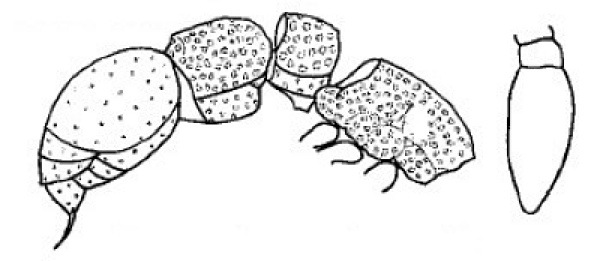 TL 2.8-3.8 mm;
sculpturation only
of scattered hair pits, reduced to tiny on gaster; petiole with concave
anterior face; shiny, colour dark brown - Parasyscia sudanensis TL 2.8-3.8 mm;
sculpturation only
of scattered hair pits, reduced to tiny on gaster; petiole with concave
anterior face; shiny, colour dark brown - Parasyscia sudanensis |
. |
| . |  |
Pan-African - sudanensis |
| -- | 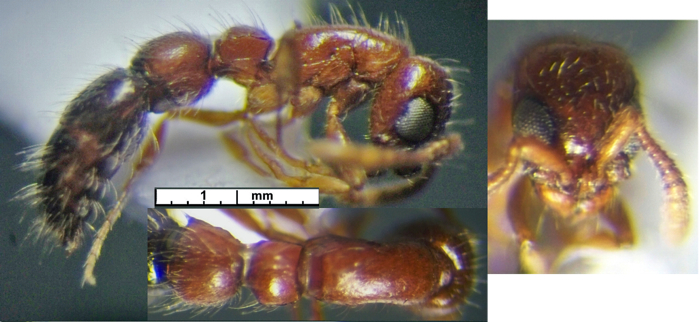 TL ca 4 mm; distinctively bicoloured with dark red-brown
posterior
to gaster contrasting to rest of body; workers speculatively associate
with type male (image on species page). TL ca 4 mm; distinctively bicoloured with dark red-brown
posterior
to gaster contrasting to rest of body; workers speculatively associate
with type male (image on species page).If so, the former synonymy under longitarsus was wrong. That has 12-segmented antennae, smaller eyes, shorter erect pilosity and a relatively small near circular postpetiole when seen from above. Separated here - in Lioponera, may = collingwoodi |
Senegal, Tunisia, Egypt & Yemen - noctambulus |
| 3 | 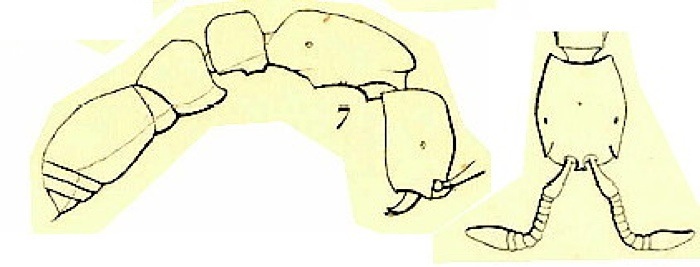 TL 3.5 mm; smooth and shiny
with almost whole of
head and alitrunk with large pits from which a yellowish hair arises,
finer pits on the posterior four segments of gaster; antennae and legs
with very fine decumbent pubescence; ferruginous yellow with apex of
gaster browner [nothing given by Brown, 1975] - Parasyscia TL 3.5 mm; smooth and shiny
with almost whole of
head and alitrunk with large pits from which a yellowish hair arises,
finer pits on the posterior four segments of gaster; antennae and legs
with very fine decumbent pubescence; ferruginous yellow with apex of
gaster browner [nothing given by Brown, 1975] - Parasyscia |
. |
| . | 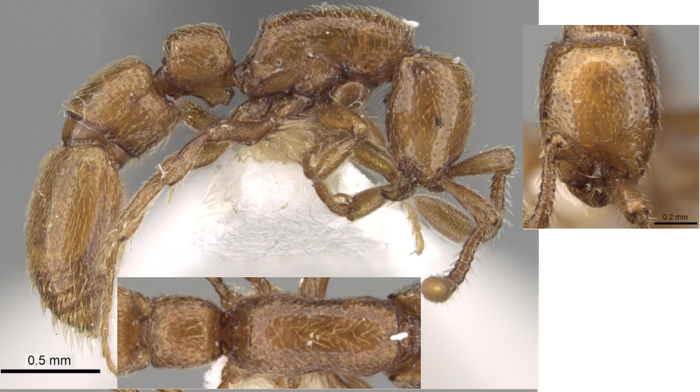 |
Syria & Lebanon {extra-limital] piochardi |
| -- |  TL 3.3-3.4 mm; shiny,
sparsely punctate;
piceous, appendages medium brown - Parasyscia nitidula TL 3.3-3.4 mm; shiny,
sparsely punctate;
piceous, appendages medium brown - Parasyscia nitidula |
. |
| . | 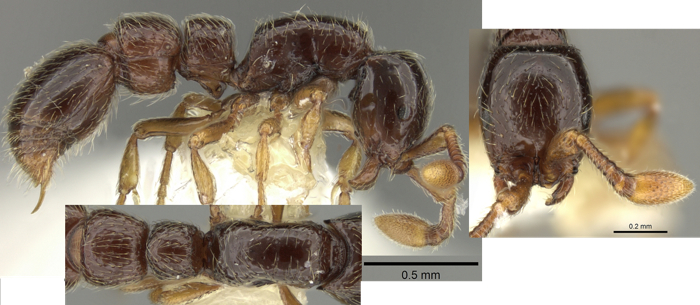 |
West Africa & Congo Basin - nitidulus |
| Antennae with
12-segments |
||
| 4 | 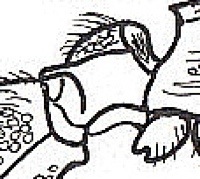 Petiole node with
sharp
dorsolateral angles - the Borowiec Lioponera Petiole node with
sharp
dorsolateral angles - the Borowiec Lioponera |
5 |
| -- |  Petiole node
without
dorsolateral margins, dorsum smoothly rounding into sides - the
Borowiec Parasyscia Petiole node
without
dorsolateral margins, dorsum smoothly rounding into sides - the
Borowiec Parasyscia |
11 |
| 5 |  Petiole
node from above with 2 broadly rounded nodes, separated by a deep
concavity; TL 3.5 mm; piceous - Lioponera Petiole
node from above with 2 broadly rounded nodes, separated by a deep
concavity; TL 3.5 mm; piceous - Lioponera |
South Africa - braunsi |
| -- | Petiole node with angulate or dentate posterolateral angles | 6 |
| 6 | Alitrunk coarsely longitudinally costulate for entire length, colour black | 7 |
| -- | Alitrunk dorsum smooth or punctate; longitudinal costulae, if any, confined to anterior and posterior extremities | 8 |
| 7 |  Head smooth; TL 3.5-3.7 mm;
dark brown to black - Lioponera Head smooth; TL 3.5-3.7 mm;
dark brown to black - Lioponera |
. |
| . | 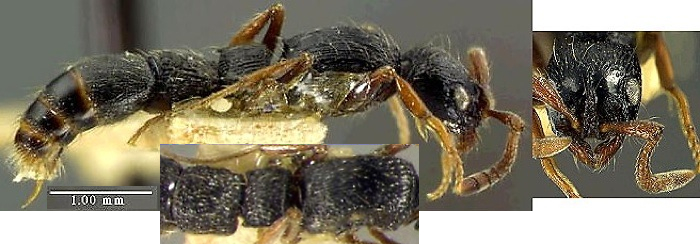 |
West Africa & Congo Basin - foreli |
| -- |  Head
with longitudinal costulae, at least on
occiput - Lioponera (separated here) Head
with longitudinal costulae, at least on
occiput - Lioponera (separated here) |
. |
| . |  |
Guinea - occipitalis |
| 8 | Petiole node with fine sculpture whereas alitrunk smooth; petiole also with much denser pubescence. Propodeal declivity smooth | 9 |
| -- | Alitrunk, petiole, postpetiole and gaster shining, with small but very distinct round punctures | 10 |
| 9 |  Eye small < length of
apical segment of funiculus; TL 3.4 mm (Kenya) 4.2-4.5 mm (South
Africa); - Lioponera Eye small < length of
apical segment of funiculus; TL 3.4 mm (Kenya) 4.2-4.5 mm (South
Africa); - Lioponera |
. |
| . |
 cooperi cooperi |
Kenya (montane) & South Africa - vespula |
| -- | 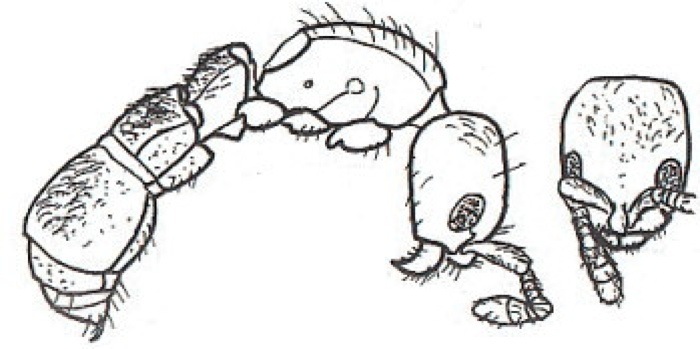 Eye larger > length of
apical segment of
funiculus; TL 2.8 mm (Nigeria slightly larger); black - Lioponera Eye larger > length of
apical segment of
funiculus; TL 2.8 mm (Nigeria slightly larger); black - Lioponera |
. |
| . | 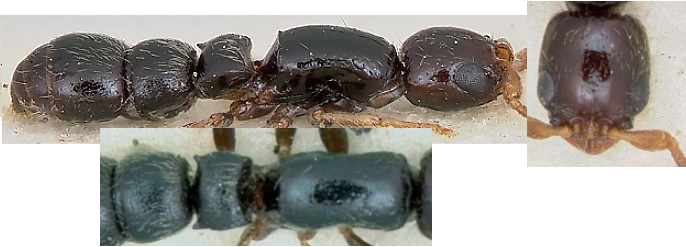 |
Zimbabwe & Nigeria - coxalis |
| 10 | 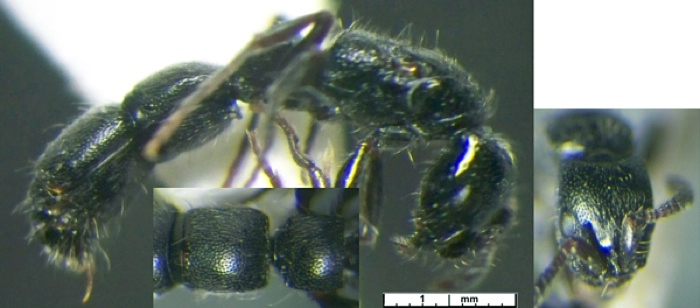 TL
4.2-4.6 mm; scape reaches posterior third of head; shiny, black (queen
shown) - Lioponera TL
4.2-4.6 mm; scape reaches posterior third of head; shiny, black (queen
shown) - Lioponera
|
Congo Basin - nkomoensis |
| -- | 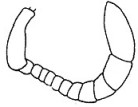 TL 2.8 mm; petiole without
postero-dorsal teeth; colour ferruginous except lower postpetiole and
gaster which are black - Lioponera TL 2.8 mm; petiole without
postero-dorsal teeth; colour ferruginous except lower postpetiole and
gaster which are black - Lioponera |
Kenya - braytoni |
| Petiole
node without dorsolateral margins, dorsum smoothly rounding into sides (Parasyscia in Borowiec, 2016) |
-- | |
| 11 | Eyes minute or absent | 12 |
| -- | Eye quite distinct to moderate in size | 13 |
| 12 | 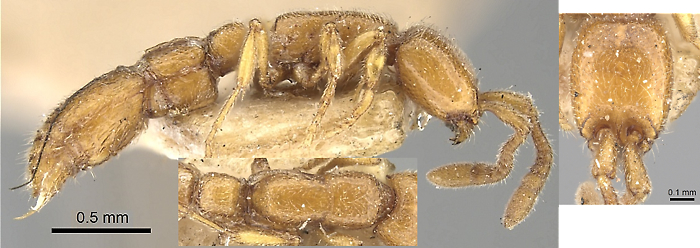 TL 2.0-2.3
mm; with distinct promesonotal suture; eyes absent; smooth (other than
punctures) and shiny, yellow brown TL 2.0-2.3
mm; with distinct promesonotal suture; eyes absent; smooth (other than
punctures) and shiny, yellow brownPlaced in new genus Europone by Borowiec, 2016 |
southern Africa - wroughtoni |
| -- | 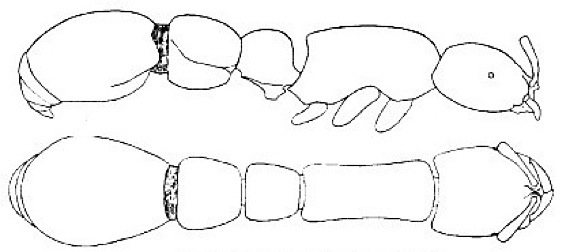 TL 4.3 mm; promesonotum
without any sign of
suture; eye very small but distinct; dark ferruginous TL 4.3 mm; promesonotum
without any sign of
suture; eye very small but distinct; dark ferruginousConsani (1951) stated the eye had a single ommatidia - Parasyscia |
. |
| . |  |
East Africa - kenyensis |
| 13 | 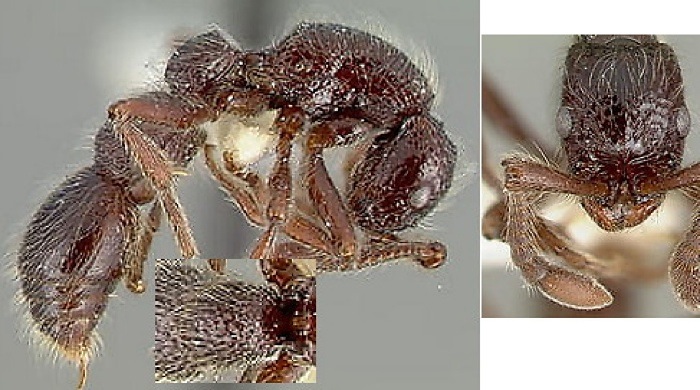 Petiole node slightly but
distinctly longer than
broad; TL 5.6-5.7 mm - Parasyscia Petiole node slightly but
distinctly longer than
broad; TL 5.6-5.7 mm - Parasyscia |
Central Africa - centurio |
| -- | Petiole node broader than long | 14 |
| 14 | Petiole node with distinct median point in posterodorsal margin | 15 |
| -- | Petiole node with straight or slightly concave posterodorsal margin | 16 |
| 15 |  TL 4.0 mm; petiole with
median point in
posterior margin, dorsum in profile convex; ventral lobe of petiole
with distinctive angles at anterior and posterior; castaneous - Parasyscia TL 4.0 mm; petiole with
median point in
posterior margin, dorsum in profile convex; ventral lobe of petiole
with distinctive angles at anterior and posterior; castaneous - Parasyscia |
. |
| . |  |
South Africa - peringueyi |
| -- |  TL
2.4-3.0 mm; black; petiole with flat dorsum
in profile - Parasyscia TL
2.4-3.0 mm; black; petiole with flat dorsum
in profile - Parasyscia |
. |
| .. |  |
East & southern Africa - afer |
| -- | 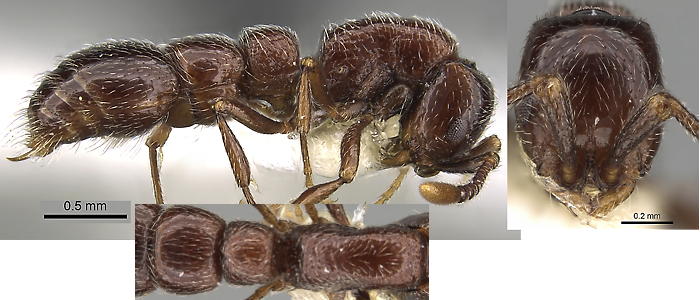 TL 3.5 mm; petiole assumed similar;
paler and more reddish than peringueyi - Parasyscia TL 3.5 mm; petiole assumed similar;
paler and more reddish than peringueyi - Parasyscia |
South Africa - arnoldi |
| 16 |  TL 4.3 mm; dorsum of head,
alitrunk and pedicel
very finely roughened and opaque; first gastral segment with very fine
dense puncturation on shiny surface; black - Parasyscia TL 4.3 mm; dorsum of head,
alitrunk and pedicel
very finely roughened and opaque; first gastral segment with very fine
dense puncturation on shiny surface; black - Parasyscia |
. |
| . |  |
South Africa - sylvicola |
| -- | Dorsum of head mostly smooth or nearly so | 17 |
| 17 | 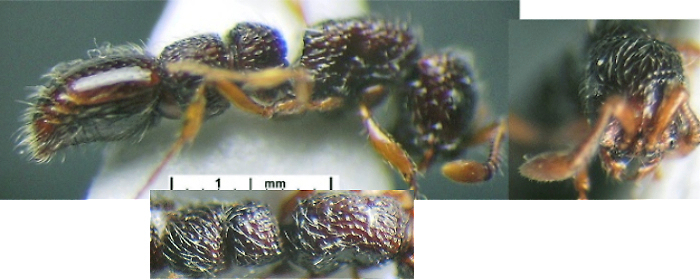 TL 5.0 mm; petiole and
postpetiole with coarse,
contiguous and confluent punctures; dark reddish-brown - Parasyscia TL 5.0 mm; petiole and
postpetiole with coarse,
contiguous and confluent punctures; dark reddish-brown - Parasyscia |
east and south central Africa - lamborni |
| -- | Petiole and postpetiole otherwise sculptured | 18 |
| 18 |  TL 4.3 mm; petiole from above
near square; black - Parasyscia valida TL 4.3 mm; petiole from above
near square; black - Parasyscia valida |
Zimbabwe - validus |
| -- | Petiole from above with posterior wider than anterior | 19 |
| 19 |  TL 2.7 mm; pale burnt sienna
brown - Parasyscia TL 2.7 mm; pale burnt sienna
brown - Parasyscia |
. |
| . |  |
South Africa & Tanzania - faurei |
| -- | Darker reddish-brown to black | 20 |
| 20 | 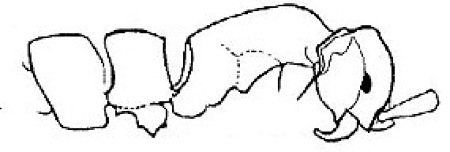 TL 2.6 mm; head, alitrunk
and petiole with large
deep puncturations; uniform brown-red, shiny, appendages yellow - Parasyscia TL 2.6 mm; head, alitrunk
and petiole with large
deep puncturations; uniform brown-red, shiny, appendages yellow - Parasyscia |
. |
| . | 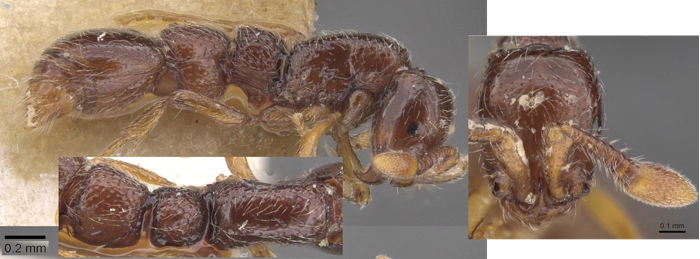 |
Guinea - villiersi |
| -- | Head, alitrunk and petiole with smaller, shallower puncturations | 21 |
| 21 | 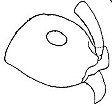 TL 3.7-4.0 mm; postpetiole
with deep ventral process; sculpturation of small hair pits;
blackish-brown, apices of body and appendages brownish-red - Parasyscia TL 3.7-4.0 mm; postpetiole
with deep ventral process; sculpturation of small hair pits;
blackish-brown, apices of body and appendages brownish-red - Parasyscia |
. |
| . | 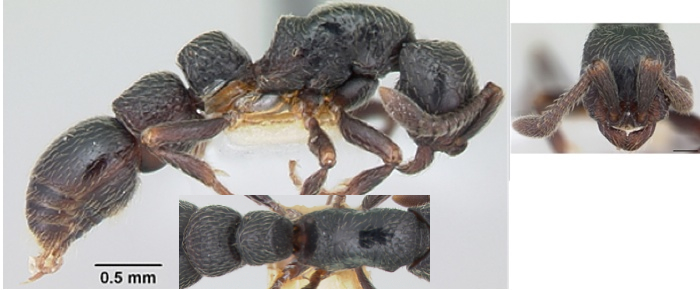 |
West Africa & Congo Basin, east into Kenya - cribrinodis |
| -- | 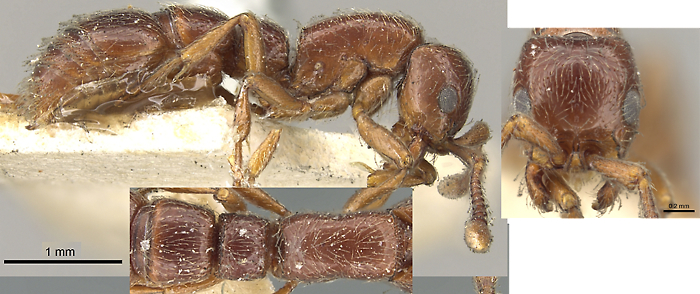 TL 4.0 mm;
pronotum wider; pedicel more weakly sculptured but alitrunk and head
more densely punctured; antennae and mandibles entirely reddish - Parasyscia TL 4.0 mm;
pronotum wider; pedicel more weakly sculptured but alitrunk and head
more densely punctured; antennae and mandibles entirely reddish - Parasyscia |
South Africa - natalensis |
|
© 2007, 2008, 2009, 2010, 2011, 2013, 2014, 2015, 2017 -
Brian
Taylor
CBiol FRSB FRES 11, Grazingfield, Wilford, Nottingham, NG11 7FN, U.K. |
href="cerapachys.htm"